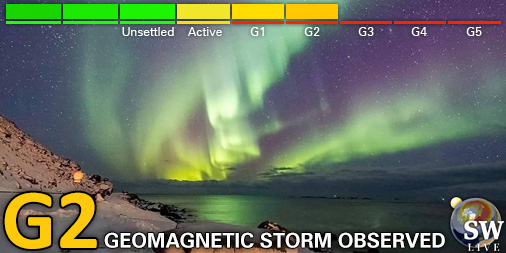Viewing archive of Thursday, 2 January 2014
Daily bulletin on solar and geomagnetic activity from the SIDC
Issued: 2014 Jan 02 1245 UTC
SIDC Forecast
Solar flares
Active (M-class flares expected, probability >=50%)
Geomagnetism
Minor storm expected (A>=30 or K=5)
Solar protons
Warning condition (activity levels expected to increase, but no numeric forecast given)
| 10cm flux | Ap | |
|---|---|---|
| 02 Jan 2014 | 165 | 022 |
| 03 Jan 2014 | 170 | 008 |
| 04 Jan 2014 | 170 | 008 |
Bulletin
Solar activity was at active levels during the past 24 hours. The strongest event, an M9.9 flare, occurred in NOAA AR 1936 (no Catania numbering yet) and peaked on January 1 at 18:52 UT. The event was associated with a slow CME (estimated projected speed 400 km/s) with first observation in LASCO/C2 at 20:00 UT. This CME might reach Earth on January 5 around 22h UT. New region NOAA AR 1944, located at S05E76, also produced an M1.7 and three C flares. A prominence eruption occurred on January 1 from around 13:00 UT located in the southeast quadrant and seems associated with a CME. This CME mainly is mainly southward directed and is not expected to reach the Earth. More M flares are likely to occur, especially from NOAA ARs 1936 and 1944. There is a moderate chance for an X flare. We maintain the warning condition for proton events. Solar wind data measured by ACE indicate the arrival of a coronal hole fast speed stream. Solar wind speed is about 600 km/s. The magnitude of the interplanetary magnetic field reached a maximum of 17 nT, with a Bz- component varying between -13 and +8 nT. Current geomagnetic conditions are unsettled to active (Kp 3 to 4). Unsettled to minor storm conditions (Kp 3 to 5) are expected due to the possible arrival of the CMEs of December 29 and December 31.
Today's estimated international sunspot number (ISN): 092, based on 08 stations.Solar indices for 01 Jan 2014
| Wolf number Catania | /// |
| 10cm solar flux | 160 |
| AK Chambon La Forêt | 028 |
| AK Wingst | 012 |
| Estimated Ap | 013 |
| Estimated international sunspot number | 084 - Based on 14 stations |
Noticeable events summary
| Day | Begin | Max | End | Loc | Strength | OP | 10cm | Catania/NOAA | Radio burst types |
|---|---|---|---|---|---|---|---|---|---|
| 01 | 1840 | 1852 | 1903 | S14W47 | M9.9 | 2B | --/1936 | ||
| 02 | 0224 | 0233 | 0256 | S05E76 | M1.7 | SF | --/1944 | CTM/1III/1 |
Provided by the Solar Influences Data analysis Center© - SIDC - Processed by SpaceWeatherLive
All times in UTC
Current data suggests there is a slight possibility for aurora to appear at the following middle latitude regions in the near future
YakutskCurrent data suggests there is a slight possibility for aurora to appear at the following low latitude regions in the near future
Krasnoyarsk, NovosibirskLatest news
Latest forum messages
Support SpaceWeatherLive.com!
A lot of people come to SpaceWeatherLive to follow the Sun's activity or if there is aurora to be seen, but with more traffic comes higher server costs. Consider a donation if you enjoy SpaceWeatherLive so we can keep the website online!

Latest alerts
15:30 UTC - Geomagnetic activity
Minor G1 geomagnetic storm (Kp5) Threshold Reached: 15:20 UTC
14:30 UTC - Geomagnetic activity
Strong G3 geomagnetic storm (Kp7) Threshold Reached: 14:18 UTC
13:30 UTC - Geomagnetic activity
Moderate G2 geomagnetic storm (Kp6) Threshold Reached: 13:21 UTC
13:18 UTC - Hemispheric Power Index
The OVATION model predicts the Hemispheric Power Index to reach 125GW at 14:01 UTC
13:15 UTC - Geomagnetic activity
Minor G1 geomagnetic storm (Kp5) Threshold Reached: 13:13 UTC
Space weather facts
| Last X-flare | 2025/03/28 | X1.1 |
| Last M-flare | 2025/04/15 | M1.2 |
| Last geomagnetic storm | 2025/04/15 | Kp6+ (G2) |
| Spotless days | |
|---|---|
| Last spotless day | 2022/06/08 |
| Monthly mean Sunspot Number | |
|---|---|
| March 2025 | 134.2 -20.4 |
| April 2025 | 124.1 -10.1 |
| Last 30 days | 124.7 -16.6 |






